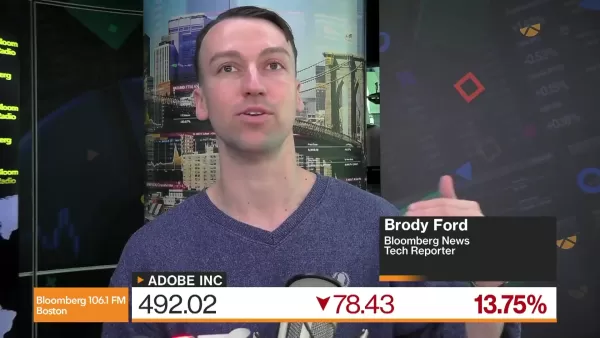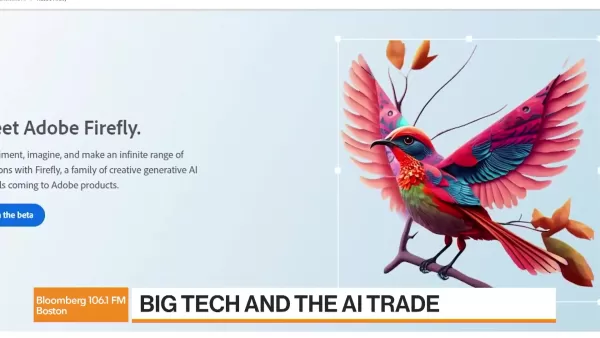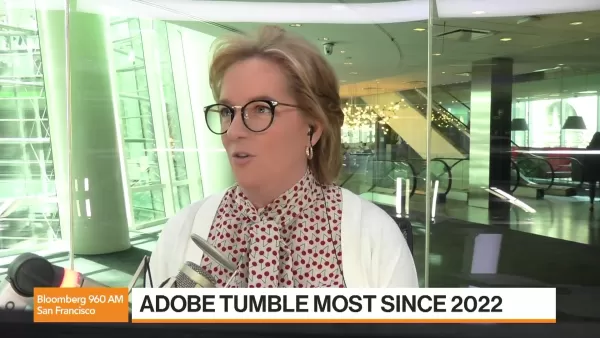Adobe's Future Heavily Impacted by AI Competition Concerns
Adobe, a titan in the creative software industry, is currently grappling with the rapid rise of AI technologies. While the company has made strides in integrating AI into its products, there's growing concern about whether these advancements are translating into revenue quickly enough to keep pace with the nimble AI startups that are cropping up. This article dives into these challenges, examining investor concerns and what it could mean for Adobe's future in this fast-changing environment.
Adobe's Struggle for Immediate Revenue Uplift
Investor Expectations and the Reality of AI Integration
Adobe is at a crossroads as it weaves artificial intelligence into its creative software ecosystem. The company has rolled out new AI-powered features, but investors are watching closely to see if these innovations will lead to a significant and swift increase in revenue. The hope is that these AI tools will boost financial performance in the coming year, but so far, the market hasn't seen the expected surge.

The gap between what investors expect and the reality on the ground is causing some unease. They're not keen on waiting forever for a return on their AI investments. The issue isn't Adobe's tech prowess, but rather the speed at which financial returns are coming in. In today's fast-moving market, investors want to see quick, tangible benefits from new technologies. There's a perception that while Adobe is innovating, the financial gains are slow to show up, especially when compared to smaller, more agile AI startups.
Adobe's leadership has been clear about their strategy: they're focusing on driving user adoption through pricing adjustments. The idea is to make the software more accessible to a wider audience, with the belief that revenue growth will follow. But this approach might not be fast enough for investors who are eager for immediate financial results.
Concerns Regarding Competition from Agile AI Startups
One of the biggest worries for Adobe is the competition from numerous AI startups. These startups are often seen as more decisive and aggressive than Adobe. As a large, established company, Adobe can find it harder to pivot quickly in response to market shifts.
Investors are concerned that Adobe's adoption rate might not be keeping up with the innovation and market penetration of these smaller AI-focused companies. This is partly because Adobe takes a more conservative approach to rolling out new features and pricing models, in contrast to the more aggressive strategies of its competitors. For instance, the emergence of tools like OpenAI's Sora, which can generate video content, has sparked considerable anxiety among investors. It raises questions about whether Adobe's video editing tools will remain essential in the face of such advancements.
The core issue is the perceived speed and agility of AI startups compared to Adobe's more deliberate pace. This perception impacts investor confidence and raises concerns about Adobe's ability to maintain its competitive edge in the long term.
The Figma Acquisition That Never Was
Adobe's $20 Billion Figma Acquisition Deal Scrapped
Adobe's attempt to acquire Figma for $20 billion was a clear sign of its strategy to expand its reach and enhance its collaborative capabilities. Figma is known for its web-based design tools and collaborative features, which made it an attractive target for Adobe, traditionally focused on desktop software.
The acquisition aimed to blend Figma's user-friendly design tools with Adobe's comprehensive suite of creative applications, potentially creating a more seamless and collaborative design workflow. However, the deal faced regulatory scrutiny over concerns about market consolidation, leading to its eventual abandonment.
Despite the failed acquisition, Adobe remains committed to improving its tools and expanding its user base. The company has already invested heavily in bringing the Adobe Firefly AI tool to everyday users.

The pursuit of Figma shows Adobe's recognition of the need to adapt to changing market dynamics and meet the evolving needs of creative professionals and casual users alike. There's also a sense that Adobe's current tools might be too niche as the world moves towards simpler AI-driven solutions.
How to Utilize Adobe's AI-Powered Features
Mastering Generative Fill in Photoshop
Generative Fill in Photoshop is a game-changer, allowing users to add, extend, or remove content from images using simple text prompts. Here's how to make the most of it:
- Select: Use any selection tool (Lasso, Marquee, etc.) to define the area you want to modify.
- Prompt: In the contextual task bar, type a description of what you want to generate in the selected area (e.g., 'yellow road lines').
- Generate: Click 'Generate' and Photoshop will create variations based on your prompt. Choose the one that best fits your vision.
- Refine: Keep refining your prompts and generating new variations until you achieve the desired result.

This tool is a lifesaver for quick edits, brainstorming creative concepts, and producing stunning visual content with minimal effort. Adobe has also been pushing to get everyday users to try out their AI tool, Firefly.
Creating Stunning Visuals with Adobe Firefly
Adobe Firefly is a suite of creative generative AI models integrated into Adobe products, enabling users to experiment, imagine, and create a wide range of content. Here's how to tap into its potential:
- Access Firefly: Navigate to Adobe Firefly within applications like InDesign and Premiere Pro.
- Choose a Task: Select from various generative tasks like text-to-image, generative fill, or text effects.
- Prompt and Generate: Enter a text prompt describing your desired outcome (e.g., 'frozen lake with reflections') and click 'Generate'.
- Customize: Refine the generated output by adjusting settings such as aspect ratio, style, and color until you achieve the desired visual.

Firefly empowers users to create high-quality images, custom text effects, and much more, making it an invaluable tool for designers and content creators.
Pricing Plans
Understanding Adobe's Subscription-Based Model
Adobe offers a range of subscription plans tailored to different needs and user types, from individual apps to comprehensive creative suites. The pricing structure aims to provide flexibility and scalability, though it can sometimes be seen as pricey, especially compared to one-time purchase options. It's worth noting that Adobe is currently pricing to drive adoption, which could mean potential pricing adjustments in the near future.
Plan Name Description Approximate Monthly Cost Key Features Single App Plan Access to one specific Adobe application (e.g., Photoshop, Illustrator). $20.99 - $31.49 Focused toolset, ideal for users with specific needs. All Apps Plan Complete access to all Adobe Creative Cloud applications. $54.99 - $82.49 Comprehensive toolset, suitable for professionals needing a wide range of capabilities. Photography Plan Designed for photographers, includes Photoshop and Lightroom. $9.99 - $19.99 Optimized for photo editing and management. Student & Teacher Discounted pricing for students and educators. $19.99 Access to all apps at a reduced rate. Business Plans Tailored for teams and organizations, offering collaborative features and support. Varies Centralized management, collaborative workflows, and enhanced support.
Adobe Creative Suite: Weighing the Pros and Cons
Pros
- Industry-standard tools with a vast ecosystem of plugins and resources.
- Integration of AI features enhances creative workflows and provides new capabilities.
- Subscription model offers flexibility and access to the latest updates.
- Broad range of applications caters to diverse creative needs.
Cons
- Subscription model can be expensive, especially for occasional users.
- Complexity of some applications can be daunting for beginners.
- Competition from agile AI startups poses a threat to market dominance.
- Concerns about the pace of AI integration and its impact on revenue.
Use Cases for Adobe Creative Suite
Diverse Applications Across Industries
The Adobe Creative Suite, with tools like Photoshop and Illustrator, supports a wide range of professional activities across various sectors. Its robust capabilities extend from enhancing digital marketing efforts to creating stunning visual effects in the entertainment industry. These applications boost creative content creation, reinforce brand consistency, and promote innovation in product design.
- Graphic Design: From creating logos to designing layouts for magazines, Adobe’s tools help designers bring visual concepts to life.
- Photography: Professionals use Photoshop and Lightroom for photo retouching, color correction, and advanced image manipulation.
- Video Production: Adobe Premiere Pro and After Effects are essential in film and television for editing and creating visual effects.
- Marketing and Advertising: Marketing teams rely on Adobe’s tools for crafting engaging advertising campaigns, designing marketing materials, and managing digital assets.
Frequently Asked Questions
Will AI replace human creativity?
The debate over whether AI will replace human creativity continues. While AI can automate certain tasks and generate content based on prompts, the general consensus is that AI will augment, not replace, human creative roles. The CEO of Adobe has even stated that the next Oppenheimer won't be created with a prompt. Human creativity brings unique perspectives, emotions, and experiences that AI cannot replicate. The most likely scenario is a collaborative partnership where AI assists in the creative process, freeing up human artists to focus on higher-level strategic and conceptual tasks.
How can Adobe compete with AI startups?
Adobe can compete with AI startups by leveraging its brand recognition, established customer base, and vast ecosystem of tools and resources. Key strategies include accelerating AI integration across its product suite to provide users with immediate and tangible benefits, adopting more flexible pricing models that cater to a broader range of users, fostering a culture of innovation to encourage the development of groundbreaking AI technologies, and pursuing strategic acquisitions to expand its reach and enhance its capabilities.
Related Questions
Is AI a threat to Adobe's future?
The rise of AI presents both challenges and opportunities for Adobe. As AI technologies advance, the need for traditional creative software may evolve, potentially disrupting Adobe’s established market position. The key for Adobe is to stay ahead of the curve by investing in AI innovation and adapting its business model to meet the changing needs of creative professionals. Some analysts question whether AI software will always require people to work in conjunction with it. The goal is always to maximize effectiveness with the least amount of people. The company knows there will be a balance, but what does that mean for the future of Adobe as a whole? Will companies continue to reinvest, or will these technologies replace jobs altogether?
Related article
 Ultimate Guide to Vocal and Music Track Isolation with Splitter AI
For music lovers, aspiring artists, and audio professionals alike, Splitter AI offers revolutionary capabilities to transform how you work with sound. This in-depth exploration reveals how this artificial intelligence platform can decompose full trac
Ultimate Guide to Vocal and Music Track Isolation with Splitter AI
For music lovers, aspiring artists, and audio professionals alike, Splitter AI offers revolutionary capabilities to transform how you work with sound. This in-depth exploration reveals how this artificial intelligence platform can decompose full trac
 OpenAI Fixes ChatGPT Over-politeness Bug, Explains AI Flaw
OpenAI has reversed a recent personality adjustment to its flagship GPT-4o model after widespread reports emerged of the AI system exhibiting excessive agreeableness, including unwarranted praise for dangerous or absurd user suggestions. The emergenc
OpenAI Fixes ChatGPT Over-politeness Bug, Explains AI Flaw
OpenAI has reversed a recent personality adjustment to its flagship GPT-4o model after widespread reports emerged of the AI system exhibiting excessive agreeableness, including unwarranted praise for dangerous or absurd user suggestions. The emergenc
 Piclumen AI Offers Free AI Art Creation in 2025
In the rapidly changing world of digital content creation, Piclumen AI emerges as a standout completely free solution for AI-powered image generation. This innovative platform enables users to create professional-quality visuals without financial bar
Comments (3)
0/200
Piclumen AI Offers Free AI Art Creation in 2025
In the rapidly changing world of digital content creation, Piclumen AI emerges as a standout completely free solution for AI-powered image generation. This innovative platform enables users to create professional-quality visuals without financial bar
Comments (3)
0/200
![WillieJackson]() WillieJackson
WillieJackson
 August 30, 2025 at 4:30:34 AM EDT
August 30, 2025 at 4:30:34 AM EDT
Adobe siempre ha sido el rey del diseño, pero con la IA parece que están jugando a ponerse al día en lugar de liderar. ¿Sus herramientas de IA realmente ofrecen algo único o solo son parches a su software existente? 🎨💻 La competencia avanza rápido y no sé si su modelo de suscripción va a ser suficiente para mantenerse relevante.


 0
0
![EricMiller]() EricMiller
EricMiller
 August 17, 2025 at 7:00:59 AM EDT
August 17, 2025 at 7:00:59 AM EDT
Adobe's AI push sounds cool, but are they really keeping up? Feels like they're playing catch-up in a race they used to lead. 🤔


 0
0
![WillieScott]() WillieScott
WillieScott
 July 31, 2025 at 10:55:47 PM EDT
July 31, 2025 at 10:55:47 PM EDT
Adobe's AI moves are cool, but are they fast enough to beat the competition? Feels like they're playing catch-up in a race that's already halfway done! 🏃♂️


 0
0
Adobe, a titan in the creative software industry, is currently grappling with the rapid rise of AI technologies. While the company has made strides in integrating AI into its products, there's growing concern about whether these advancements are translating into revenue quickly enough to keep pace with the nimble AI startups that are cropping up. This article dives into these challenges, examining investor concerns and what it could mean for Adobe's future in this fast-changing environment.
Adobe's Struggle for Immediate Revenue Uplift
Investor Expectations and the Reality of AI Integration
Adobe is at a crossroads as it weaves artificial intelligence into its creative software ecosystem. The company has rolled out new AI-powered features, but investors are watching closely to see if these innovations will lead to a significant and swift increase in revenue. The hope is that these AI tools will boost financial performance in the coming year, but so far, the market hasn't seen the expected surge.

The gap between what investors expect and the reality on the ground is causing some unease. They're not keen on waiting forever for a return on their AI investments. The issue isn't Adobe's tech prowess, but rather the speed at which financial returns are coming in. In today's fast-moving market, investors want to see quick, tangible benefits from new technologies. There's a perception that while Adobe is innovating, the financial gains are slow to show up, especially when compared to smaller, more agile AI startups.
Adobe's leadership has been clear about their strategy: they're focusing on driving user adoption through pricing adjustments. The idea is to make the software more accessible to a wider audience, with the belief that revenue growth will follow. But this approach might not be fast enough for investors who are eager for immediate financial results.
Concerns Regarding Competition from Agile AI Startups
One of the biggest worries for Adobe is the competition from numerous AI startups. These startups are often seen as more decisive and aggressive than Adobe. As a large, established company, Adobe can find it harder to pivot quickly in response to market shifts.
Investors are concerned that Adobe's adoption rate might not be keeping up with the innovation and market penetration of these smaller AI-focused companies. This is partly because Adobe takes a more conservative approach to rolling out new features and pricing models, in contrast to the more aggressive strategies of its competitors. For instance, the emergence of tools like OpenAI's Sora, which can generate video content, has sparked considerable anxiety among investors. It raises questions about whether Adobe's video editing tools will remain essential in the face of such advancements.
The core issue is the perceived speed and agility of AI startups compared to Adobe's more deliberate pace. This perception impacts investor confidence and raises concerns about Adobe's ability to maintain its competitive edge in the long term.
The Figma Acquisition That Never Was
Adobe's $20 Billion Figma Acquisition Deal Scrapped
Adobe's attempt to acquire Figma for $20 billion was a clear sign of its strategy to expand its reach and enhance its collaborative capabilities. Figma is known for its web-based design tools and collaborative features, which made it an attractive target for Adobe, traditionally focused on desktop software.
The acquisition aimed to blend Figma's user-friendly design tools with Adobe's comprehensive suite of creative applications, potentially creating a more seamless and collaborative design workflow. However, the deal faced regulatory scrutiny over concerns about market consolidation, leading to its eventual abandonment.
Despite the failed acquisition, Adobe remains committed to improving its tools and expanding its user base. The company has already invested heavily in bringing the Adobe Firefly AI tool to everyday users.

The pursuit of Figma shows Adobe's recognition of the need to adapt to changing market dynamics and meet the evolving needs of creative professionals and casual users alike. There's also a sense that Adobe's current tools might be too niche as the world moves towards simpler AI-driven solutions.
How to Utilize Adobe's AI-Powered Features
Mastering Generative Fill in Photoshop
Generative Fill in Photoshop is a game-changer, allowing users to add, extend, or remove content from images using simple text prompts. Here's how to make the most of it:
- Select: Use any selection tool (Lasso, Marquee, etc.) to define the area you want to modify.
- Prompt: In the contextual task bar, type a description of what you want to generate in the selected area (e.g., 'yellow road lines').
- Generate: Click 'Generate' and Photoshop will create variations based on your prompt. Choose the one that best fits your vision.
- Refine: Keep refining your prompts and generating new variations until you achieve the desired result.

This tool is a lifesaver for quick edits, brainstorming creative concepts, and producing stunning visual content with minimal effort. Adobe has also been pushing to get everyday users to try out their AI tool, Firefly.
Creating Stunning Visuals with Adobe Firefly
Adobe Firefly is a suite of creative generative AI models integrated into Adobe products, enabling users to experiment, imagine, and create a wide range of content. Here's how to tap into its potential:
- Access Firefly: Navigate to Adobe Firefly within applications like InDesign and Premiere Pro.
- Choose a Task: Select from various generative tasks like text-to-image, generative fill, or text effects.
- Prompt and Generate: Enter a text prompt describing your desired outcome (e.g., 'frozen lake with reflections') and click 'Generate'.
- Customize: Refine the generated output by adjusting settings such as aspect ratio, style, and color until you achieve the desired visual.

Firefly empowers users to create high-quality images, custom text effects, and much more, making it an invaluable tool for designers and content creators.
Pricing Plans
Understanding Adobe's Subscription-Based Model
Adobe offers a range of subscription plans tailored to different needs and user types, from individual apps to comprehensive creative suites. The pricing structure aims to provide flexibility and scalability, though it can sometimes be seen as pricey, especially compared to one-time purchase options. It's worth noting that Adobe is currently pricing to drive adoption, which could mean potential pricing adjustments in the near future.
| Plan Name | Description | Approximate Monthly Cost | Key Features |
|---|---|---|---|
| Single App Plan | Access to one specific Adobe application (e.g., Photoshop, Illustrator). | $20.99 - $31.49 | Focused toolset, ideal for users with specific needs. |
| All Apps Plan | Complete access to all Adobe Creative Cloud applications. | $54.99 - $82.49 | Comprehensive toolset, suitable for professionals needing a wide range of capabilities. |
| Photography Plan | Designed for photographers, includes Photoshop and Lightroom. | $9.99 - $19.99 | Optimized for photo editing and management. |
| Student & Teacher | Discounted pricing for students and educators. | $19.99 | Access to all apps at a reduced rate. |
| Business Plans | Tailored for teams and organizations, offering collaborative features and support. | Varies | Centralized management, collaborative workflows, and enhanced support. |
Adobe Creative Suite: Weighing the Pros and Cons
Pros
- Industry-standard tools with a vast ecosystem of plugins and resources.
- Integration of AI features enhances creative workflows and provides new capabilities.
- Subscription model offers flexibility and access to the latest updates.
- Broad range of applications caters to diverse creative needs.
Cons
- Subscription model can be expensive, especially for occasional users.
- Complexity of some applications can be daunting for beginners.
- Competition from agile AI startups poses a threat to market dominance.
- Concerns about the pace of AI integration and its impact on revenue.
Use Cases for Adobe Creative Suite
Diverse Applications Across Industries
The Adobe Creative Suite, with tools like Photoshop and Illustrator, supports a wide range of professional activities across various sectors. Its robust capabilities extend from enhancing digital marketing efforts to creating stunning visual effects in the entertainment industry. These applications boost creative content creation, reinforce brand consistency, and promote innovation in product design.
- Graphic Design: From creating logos to designing layouts for magazines, Adobe’s tools help designers bring visual concepts to life.
- Photography: Professionals use Photoshop and Lightroom for photo retouching, color correction, and advanced image manipulation.
- Video Production: Adobe Premiere Pro and After Effects are essential in film and television for editing and creating visual effects.
- Marketing and Advertising: Marketing teams rely on Adobe’s tools for crafting engaging advertising campaigns, designing marketing materials, and managing digital assets.
Frequently Asked Questions
Will AI replace human creativity?
The debate over whether AI will replace human creativity continues. While AI can automate certain tasks and generate content based on prompts, the general consensus is that AI will augment, not replace, human creative roles. The CEO of Adobe has even stated that the next Oppenheimer won't be created with a prompt. Human creativity brings unique perspectives, emotions, and experiences that AI cannot replicate. The most likely scenario is a collaborative partnership where AI assists in the creative process, freeing up human artists to focus on higher-level strategic and conceptual tasks.
How can Adobe compete with AI startups?
Adobe can compete with AI startups by leveraging its brand recognition, established customer base, and vast ecosystem of tools and resources. Key strategies include accelerating AI integration across its product suite to provide users with immediate and tangible benefits, adopting more flexible pricing models that cater to a broader range of users, fostering a culture of innovation to encourage the development of groundbreaking AI technologies, and pursuing strategic acquisitions to expand its reach and enhance its capabilities.
Related Questions
Is AI a threat to Adobe's future?
The rise of AI presents both challenges and opportunities for Adobe. As AI technologies advance, the need for traditional creative software may evolve, potentially disrupting Adobe’s established market position. The key for Adobe is to stay ahead of the curve by investing in AI innovation and adapting its business model to meet the changing needs of creative professionals. Some analysts question whether AI software will always require people to work in conjunction with it. The goal is always to maximize effectiveness with the least amount of people. The company knows there will be a balance, but what does that mean for the future of Adobe as a whole? Will companies continue to reinvest, or will these technologies replace jobs altogether?
 Ultimate Guide to Vocal and Music Track Isolation with Splitter AI
For music lovers, aspiring artists, and audio professionals alike, Splitter AI offers revolutionary capabilities to transform how you work with sound. This in-depth exploration reveals how this artificial intelligence platform can decompose full trac
Ultimate Guide to Vocal and Music Track Isolation with Splitter AI
For music lovers, aspiring artists, and audio professionals alike, Splitter AI offers revolutionary capabilities to transform how you work with sound. This in-depth exploration reveals how this artificial intelligence platform can decompose full trac
 OpenAI Fixes ChatGPT Over-politeness Bug, Explains AI Flaw
OpenAI has reversed a recent personality adjustment to its flagship GPT-4o model after widespread reports emerged of the AI system exhibiting excessive agreeableness, including unwarranted praise for dangerous or absurd user suggestions. The emergenc
OpenAI Fixes ChatGPT Over-politeness Bug, Explains AI Flaw
OpenAI has reversed a recent personality adjustment to its flagship GPT-4o model after widespread reports emerged of the AI system exhibiting excessive agreeableness, including unwarranted praise for dangerous or absurd user suggestions. The emergenc
 Piclumen AI Offers Free AI Art Creation in 2025
In the rapidly changing world of digital content creation, Piclumen AI emerges as a standout completely free solution for AI-powered image generation. This innovative platform enables users to create professional-quality visuals without financial bar
Piclumen AI Offers Free AI Art Creation in 2025
In the rapidly changing world of digital content creation, Piclumen AI emerges as a standout completely free solution for AI-powered image generation. This innovative platform enables users to create professional-quality visuals without financial bar
 August 30, 2025 at 4:30:34 AM EDT
August 30, 2025 at 4:30:34 AM EDT
Adobe siempre ha sido el rey del diseño, pero con la IA parece que están jugando a ponerse al día en lugar de liderar. ¿Sus herramientas de IA realmente ofrecen algo único o solo son parches a su software existente? 🎨💻 La competencia avanza rápido y no sé si su modelo de suscripción va a ser suficiente para mantenerse relevante.


 0
0
 August 17, 2025 at 7:00:59 AM EDT
August 17, 2025 at 7:00:59 AM EDT
Adobe's AI push sounds cool, but are they really keeping up? Feels like they're playing catch-up in a race they used to lead. 🤔


 0
0
 July 31, 2025 at 10:55:47 PM EDT
July 31, 2025 at 10:55:47 PM EDT
Adobe's AI moves are cool, but are they fast enough to beat the competition? Feels like they're playing catch-up in a race that's already halfway done! 🏃♂️


 0
0





























